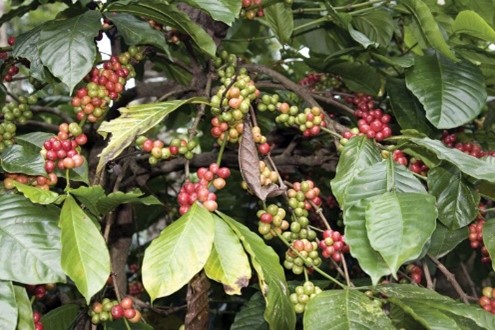Imagine going to the coffee shop and ordering your favorite drink and being told: “This beverage is not available anymore”. A nightmare is to know that the cup of your joy is going extinct, right? Everyone has a favorite drink with a special taste. They are from significant plants that have lots of stories to tell. In recent years, climate change, due to global warming and pests, has created a perfect storm that threatens their existence, and it is time to ask ourselves: Can we cope with a future without a cup of coffee?
The Coffee Tree
According to popular legend, a goat in the Ethiopian city “Kaffa” found a tree full of berries-like fruits. For its nice taste, it ate a lot of it then started to behave differently. The goat-herder, named “Kaldi”, noticed an unprecedented wide-awake feeling in one of his goats. He followed his curiosity and the goat, until he found the magical tree. He chewed on the berries himself and became alert, too. To find out its secret, he took some berries and went to the nearest place of worship.
Immediately, the berries were ordered to be put on fire to move that devilish effect away. Surprisingly, an aromatic smell that could not be overlooked filled the place, so orders were issued to save the rest of the berries from the fire and pour hot water on it to save that sensual smell. Upon tasting the mixture, the attendees experienced a calming sensation. From there, the energetic berries power spread as wildfire with various recipes worldwide known today as “Coffee”.

Coffee cherries. Credits: Encyclopædia Britannica.
There are about as many different legends about the discovery of the coffee tree as there are varieties of coffee. The coffee plants are small trees or shrubs, with oval and dark glossy green leaves. They produce a fruit, commonly referred to as a berry, with two seeds. Global coffee trade relies on two species; the brown and black beans from the coffee tree or Coffea arabica (arabica) that represents 60%–80% of the world’s coffee production, and the Coffea canephora (robusta) that grows in warm and tropical climates worldwide.
.jpg)
Credits: Encyclopædia Britannica. Coffee beans, ground coffee, and instant coffee.
In more than 50 countries, coffee is grown on largely smallholder farms. Specific temperature, light, and humidity levels are among the required criteria of coffee crops to grow properly. However, changing climate conditions is impacting coffee’s taste and aroma in farms at higher altitudes, and too much light exposure is linked to a decrease in its quality. In fact, this has to be of least concern compared to coffee’s sustainability.
Sri Lanka, for example, used to be a world coffee power but everything changed in 1869, when a disease that causes coffee leaf rust and ruins coffee plantations, known as the Hemileia vastatrix fungus, spread across the Island. After 20 years, it killed Sri Lanka’s coffee industry and began to expand around the world. In 1970, it appeared in Brazil, then spread to Central America and Colombia.
During 2012/2013, the rising temperatures led to a major coffee rust crisis in Central America, and more than half of the planted areas were destroyed. Although rust has no cure, it can be prevented; yet, with the increasing global temperature, it is getting harder to control the increase of plant diseases in coffee farms and the decrease in the quality and production of coffee worldwide.
You might have noticed recently that several coffee brands are increasing their prices; this is highly correlated with climate change. Though it can be hard to be precise about the consequences in an era of accelerated climate change, it is generally accepted that coffee output is at risk. Today, there are 124 coffee species known to science, and researchers expect at least 75 coffee species (60%) are at the risk of extinction worldwide! The threats include deforestation, plant diseases, and most importantly, temperature change that influences coffee plant’s survivability.
By 2050, 50% of the land used for growing coffee plants will not be suitable for farming, as estimated by experts. More plant diseases and damage of crops will result from intense rainfall and related pests that can survive more easily. Nevertheless, the risks of coffee extinction will not affect your morning only; it will affect several species that support our lives and livelihood, such as birds and bees, which will face threats of habitat destruction and loss, as per a recent study.
However, not all hope is to be lost! As the area suitable for growing coffee will reduce due to the rising temperatures, some other unideal areas will become hospital to the crop. Researchers also study many other new solutions to slow down the extinction and help coffee farmers combat climate change. They hope to create diverse range of coffee beans that are resistant to climate changes through plant breeding, to recreate rust-resistant varieties of coffee.
Where would you be without these precious trees? I will tell you, still in bed. The choices we make everyday affects our lives; even if we do not see that impact. We sometimes take things for granted, but we need to contemplate our world's various species. They face threats of climate change and habitat destruction as we do; nevertheless, we are the main culprit. Outreach and education are important components of the response; we must learn how to help conserve and protect these species that we have been depending on for decades before they cease just in a few decades.
References
ambius.com
britannica.com
climate.gov
delishably.com
doi.org
dw.com
espresso-international.com
iadb.org
kids.britannica.com
mashed.com
noharmdone.co
science.org
Cover Image by freepik